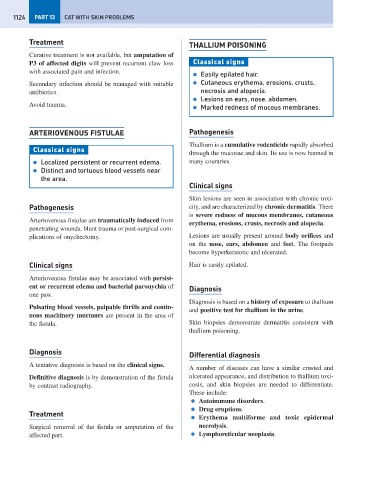Page 1132 - Problem-Based Feline Medicine
P. 1132
1124 PART 13 CAT WITH SKIN PROBLEMS
Treatment THALLIUM POISONING
Curative treatment is not available, but amputation of
P3 of affected digits will prevent recurrent claw loss Classical signs
with associated pain and infection.
● Easily epilated hair.
Secondary infection should be managed with suitable ● Cutaneous erythema, erosions, crusts,
antibiotics. necrosis and alopecia.
● Lesions on ears, nose, abdomen.
Avoid trauma.
● Marked redness of mucous membranes.
ARTERIOVENOUS FISTULAE Pathogenesis
Thallium is a cumulative rodenticide rapidly absorbed
Classical signs
through the mucosae and skin. Its use is now banned in
● Localized persistent or recurrent edema. many countries.
● Distinct and tortuous blood vessels near
the area.
Clinical signs
Skin lesions are seen in association with chronic toxi-
Pathogenesis city, and are characterized by chronic dermatitis. There
is severe redness of mucous membranes, cutaneous
Arteriovenous fistulae are traumatically induced from
erythema, erosions, crusts, necrosis and alopecia.
penetrating wounds, blunt trauma or post-surgical com-
plications of onychectomy. Lesions are usually present around body orifices and
on the nose, ears, abdomen and feet. The footpads
become hyperkeratotic and ulcerated.
Clinical signs Hair is easily epilated.
Arteriovenous fistulae may be associated with persist-
ent or recurrent edema and bacterial paronychia of Diagnosis
one paw.
Diagnosis is based on a history of exposure to thallium
Pulsating blood vessels, palpable thrills and contin-
and positive test for thallium in the urine.
uous machinery murmurs are present in the area of
the fistula. Skin biopsies demonstrate dermatitis consistent with
thallium poisoning.
Diagnosis Differential diagnosis
A tentative diagnosis is based on the clinical signs.
A number of diseases can have a similar crusted and
Definitive diagnosis is by demonstration of the fistula ulcerated appearance, and distribution to thallium toxi-
by contrast radiography. cosis, and skin biopsies are needed to differentiate.
These include:
● Autoimmune disorders.
● Drug eruptions.
Treatment
● Erythema multiforme and toxic epidermal
Surgical removal of the fistula or amputation of the necrolysis.
affected part. ● Lymphoreticular neoplasia.

